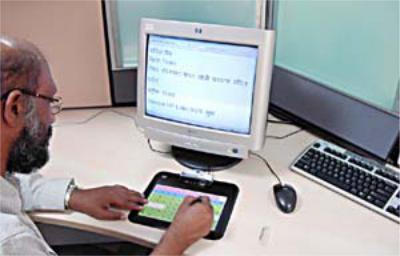HP Gesture Keyboard User Manual

Gesture Keyboard - User centered design of a unique input device for Indic Scripts♦
Ashish Krishna1, Rahul Ajmera1, Sandesh Halarnkar, Prashant Pandit
HP Laboratories India
HPL-2005-56
March 18, 2005*
devnagari text |
Indic text input presents a unique challenge in the field of keyboard |
entry, gesture |
design because of the number of standalone characters, conjuncts, matras, |
keyboard (GKB), |
and symbols. It poses a huge challenge to the HCI practitioners to |
matras, modifier, |
accommodate the humongous array of Devnagari characters in a |
syllable, IMEs |
keyboard. Solutions for input in Devnagari scripts using a physical |
|
keyboard have been around for a while but none of them have emerged as |
|
a standard mechanism due to several usability related concerns. In this |
|
paper we have described the design of a new gesture based keyboard, |
|
which has a dual input mode 1. Gesturing 2. Tapping. The "gesture |
|
keyboard" concept is based on partial hand writing recognition as well as |
|
touch-typing paradigms. Conceptually, it is a stylus sensitive keypad that |
|
supports tapping for getting the base consonants and some symbols, |
|
while it also recognizes handwritten matras as per handwriting |
|
recognition methods. This paper also reports the findings of the user |
|
study, which was carried out to find the optimum sizes of the keys and |
|
layouts. |
* Internal Accession Date Only
♦HCI International 2005, 22-27 July 2005, Las Vegas, Nevada, USA
1Human Factors International, 4th Floor, Chemtex House, Hiranandani Gardens, Mumbai – 400 076, India
Approved for External Publication
© Copyright 2005 Hewlett-Packard Development Company, L.P.
Gesture Keyboard - User centered design of a unique input device for Indic Scripts
Ashish Krishna1, Rahul Ajmera1 |
Sandesh Halarnkar and Prashant Pandit |
Human Factors International |
HP labs |
4th Floor, Chemtex House |
24, Salarpuria Arena, |
Hiranandani Gardens |
Hosur Main Road, Adugodi, |
Mumbai – 400 076 |
Bangalore, India |
{ashish.krishna, rahul.ajmera}@hp.com |
{sandesh.halarnkar, |
1 Currently at HP labs |
prashant.pandit}@hp.com |
|
Abstract
Indic text input presents a unique challenge in the field of keyboard design because of the number of standalone characters, conjuncts, matras, and symbols. It poses a huge challenge to the HCI practitioners to accommodate the humongous array of Devnagari characters in a keyboard. Solutions for input in Devnagari scripts using a physical keyboard have been around for a while but none of them have emerged as a standard mechanism due to several usability related concerns. In this paper we have described the design of a new gesture based keyboard, which has a dual input mode 1. Gesturing 2. Tapping. The “gesture keyboard” concept is based on partial hand writing recognition as well as touch-typing paradigms. Conceptually, it is a stylus sensitive keypad that supports tapping for getting the base consonants and some symbols, while it also recognizes handwritten matras as per handwriting recognition methods. This paper also reports the findings of the user study, which was carried out to find the optimum sizes of the keys and layouts.
1 Keywords
Devnagari text entry, Gesture Keyboard (GKB), Matras, Modifier, Syllable, IMEs
2 Introduction
Given the well-understood challenges of achieving high accuracy with recognition of natural handwriting and dealing with the great variability in writing styles, a number of alternative schemes (generically called Input Method Environments or IMEs) have been developed for English and some Oriental scripts. Some of these are based on development of simplified gestures (e.g. Uniscript and Graffiti for English), others are based on interactively arriving at the intended character using partial handwriting input or other cues from the user.
This new keyboard introduces a paradigm shift in text inputting methods. We have developed a prototype for Devnagari, which takes best of both worlds; it takes cues from handwriting recognition (matras formation) and touch-typing (base characters). The new design has all the base consonant keys and the user is required to make a Matra (a gesture) on top of it, to make a syllable. Thus significantly reducing the need to hunt and peck and leading to quick learnability, retention and reduced hunting load.
The Gesture Keyboard is not presented as an alternative to the conventional English keyboard but has been proposed as a peripheral input device. The user would have an additional device (GKB) connected to his workstation along with the regular ASCII English keyboard and a mouse as shown in Figure below.

Figure 1: typical computer setup with a gesture keyboard
2.1Need for a Devnagari input device
Computer usage in India is almost entirely in English and is restricted to the English-speaking, upper and uppermiddle class people. This stands in direct contrast with the demand for communication in Indian languages. Census data for the year 1991shows that English is the first language for only 0.02% of Indians and second and third language for 8% and 3% respectively. Hindi TV programs claim all the top 10 slots in television program ratings. Circulation of daily English newspapers had a market share of 15% in the year 2002. (Chand, Ganu, Joshi, Mathur & Parmar, 2004) 2001 census indicates that almost 70% of the Indian population specks 5 major languages i.e. Hindi, Bengali, Telugu, Marathi and Tamil with Hindi being the most spoken language at 40.22%. (http://www.censusindia.net/language.html)
2.2Difference with roman script
Using a standard keyboard for Devnagari scripts creates usability issues, as the Devnagari Script possesses some conceptual differences from the Roman script.
Some of these are summarized below:
•The concept of matras (character modifiers) has no parallels in the Roman script.
•Each character has a shiro rekha (the top bounding line on Devnagari characters) on top of it.
•Character modifiers, basically matras and other special characters, can occur before, on top, below or after the main character that they modify. (Deb and Deshwal, 2003)
•Since in the written form there is no clear specification of the sequence in which modifiers should be added to the consonant, sequential entry modes like a keyboard would not fit the users mental models
•More than one modifier can be attached to one consonant
2.3Issues with using an Inscript Keyboard
Current Indian language typing solutions have a steep learning curve. According to Arjun Mahanto, the Hindi Officer in IIT Bombay, learning to type requires approximately fifty hours of training and practice for a person to reach speeds of 25 words per minute. This is too much of a barrier for ordinary people and only professional typists are willing to make this investment. (Chand et al., 2004)

Figure 2: Inscript keyboard (with multiple characters on a single key)
Commercially the demand for Devnagari input has been patched by the Inscript keyboard. This is essentially a QWERTY keyboard with Devnagari characters mapped onto the keys. The minimum number of characters that are required even representing Devnagari is 54, base consonants (34), vowels (19), and a halant key. This excludes Devnagari numerals and various Vedic symbols and modifiers i.e. Ref, Ru, Half Ra. This issue manifests itself on this keyboard, which is essentially meant for entering just 26 alphabets. The aftereffect is that each key has multiple characters (two to three characters per key) mapped onto them. These additional symbols on the keys are inputted using combinations of toggle keys like shift, alt and control. This keyboard has a very high learning curve due to the multiple shift modes as is suited for professional typewriters who undergo rigorous training to learn this keyboard.
3 Introduction to the GKB
Computing devices demand text input schemes that can be quickly learnt and retained to achieve a fair speed and easy to use rather than “hunt and peck”. Roman keyboards are not particularly amenable to accommodate the phonetic non-alphabetic script like Indic. Many alternate layouts exist which are mapped on the Roman alphabets of QWERTY keyboards. However, no such known work exists for Indic scripts. (Joshi & Rathod, 2002)
Keyboards support a ten fingered typing and also have two entry modes namely expert and novice. While the novice uses “hunting and pecking” to type, experts do a head up touch-typing. So, there is always a trade off between the learning and typing speed achieved in the keyboard.
There is an analogy between keyboards and styli. Keyboards can be used with no training: the letters can be tapped out one-by-one using hunt-and-peck. This is similar to what is currently done with styli. No new training is required, and letters are printed one-by-one. However, unlike styli, keyboards have a “growth path.” With practice, hunt-and- peck with two fingers can become faster than handwriting. If even higher speeds are desired, then keyboard users can learn touch-typing. Touch-typing not only achieves high speeds, it also enables “eyes-free” operation, that is, the ability to type without having to look at your hands. This suggests that the solution to the problem of stylus text entry requires developing an analogue of touch-typing. An electronic pen (or stylus) would be more attractive as an input device if it supported expert users with some analogue of touch-typing. (Goldberg & Richardson, 1993)
Working on this analogy we tried to develop a gesture-based keyboard which had gestures enabled on each key. So that user neither has to write fully as in the case of pen based interfaces instead they can just make gestures to get a matra along with the base consonant nor touch type fully to get a syllable. In this case, the design of gesture became an important consideration for us. They have to be very intuitive and also very easy to learn.
3.1Gestures
Few major criterions for designing gesture (matras) were, 1.easy to learn, 2.fast to write and 3.easy to retain matras. Instead of developing new gestures for each Devnagari matra (as in the case of graffiti and unistrokes), we implemented these matras as they appear in the Varnmala. The only difference being the breakage of multi stroke matras into a combination of different single stroke matras. Also for a half character we designed a horizontal stroke, which was derived from the mental model of cutting a character in to half.
All these aforementioned criterions for matras were satisfied as there was no learning involved; users had to write them they way they normally write on paper. Also, the retention was easy as the users had to learn few matras namely horizontal strokes and oblique scoring for getting secondary glyphs from the keypad.
